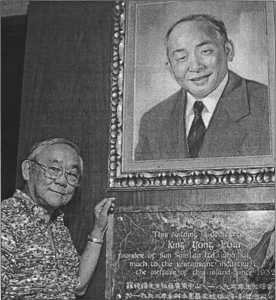James Low

Tsunamis Remembered: Oral Histories of Survivors and Observers in Hawai‘i
Life history interviews with individuals who witnessed and survived tsunamis-particularly the 1946 and 1960 disasters on the Big Island of Hawai'i. Thirty individuals-mostly residents of Hilo and Laupahoehoe-recall their experiences before; during, and after the 1946 and 1960 tsunamis which were arguably the most destructive natural disasters in modem Hawaiian history.
James "Jimmy" Low was born January 24, 1930 in Hilo. Beginning in 1926, his parents, King Yong Low of Kwangtung, China, and Mary Chow Low of Hilo, ran a grocery store on Keawe Street. 'Three years later, they branched out and opened the original Sun Sun Lau Chop Sui House on Haili Street. In 1939, the restaurant relocated to Kamehameha Avenue in downtown Hilo. Low, the fourth of seven children, grew up around the restaurant. As soon.as he was old enough, he helped his parents cook in the kitchen and set up for banquets. He attended Hilo Standard and Hilo Intermediate schools and graduated from Hilo High School. ·On April1, 1946, the sixteen-year-old Low in his father's Model A automobile, enroute to pick up provisions for the restaurant, was caught in the tsunami and barely escaped death. The restaurant suffered damages but was not destroyed. Following graduation in 1948, Low was drafted and served in Korea until 1952. In 1959, King Yong Low turned over ownership to his four sons, who incorporated the business as a limited partnership. The following year, the 1960 tsunami caused extensive damage to the restaurant, causing the Lows to temporarily relocate to an area near Waiakea Pond. With the help of the Hawai'i Redevelopment Agency, Sun Sun Lau Chop Sui House reopened at a location away from the tsunami inundation zone. Low is married to Ella Chun Low. The couple raised four children. The interviews were conducted mSun Sun Lau. A year later, in 1999, Jimmy Low closed the doors to the restaurant for the final time.
Scope and Content Note
Hilo-born son of storekeepers/restauranteurs describes his upbringing, with a focus on Shinmachi. He depicts restaurant work and the effects of World War II on business. Caught in the 1946 tsunami, he details the downtown Hilo's destruction and how he escaped, as well as the cleanup and recovery. He talks about his military service in Korea and his return to the family business. The 1960 tsunami claimed the restaurant and he explains business reconstruction and factors which led to its closure thirty years later.
Program Note:
This interview is part of the Center for Oral History's project Tsunamis Remembered: Oral Histories of Survivors and Observers in Hawai‘i. Interviews from this project are available in the Center's ScholarSpace open access repository.
The Center for Oral History (COH), in the Department of Ethnic Studies at the University of Hawaiʻi at Mānoa, collects, documents, preserves and highlights the recollections of Native Hawaiians and the multi-ethnic people of Hawaiʻi. It produces oral histories and interpretive historical materials about lifeways, key historic events, social movements and Hawaiʻi’s role in the globalizing world, for the widest possible use.
Please Note: The oral histories in this collection are protected by copyright and have been created for educational, research and personal use as described by the Fair Use Doctrine in the U.S. Copyright law. Please reach out Voices@noaa.gov to let us know how these interviews are being used in your research, project, exhibit, etc. The Voices staff can help provide other useful resources related to your inquiry.
The NOAA mission is to understand and predict changes in climate, weather, oceans, and coasts, to share that knowledge and information with others, and to conserve and manage coastal and marine ecosystems and resources. The Voices Oral History Archives offers public access to a wide range of accounts, including historical materials that are products of their particular times, and may contain offensive language or negative stereotypes.
Voices Oral History Archives does not verify the accuracy of materials submitted to us. The opinions expressed in the interviews are those of the interviewee only. The interviews here have been made available to the public only after the interviewer has confirmed that they have obtained consent.
